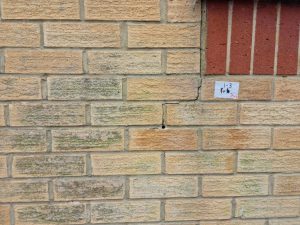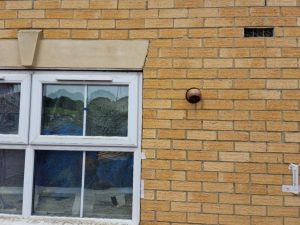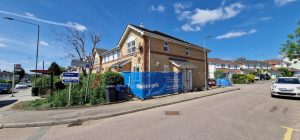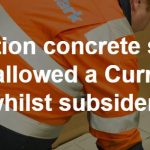Mainmark – Cementitious grouting used to re-level and stabilise London residential housing instead of traditional underpinning
Two residential buildings in Barnet, London, suffered from subsidence and heave due to the expansion of unsettled London clay soil. Building A was stabilised using the traditional underpinning method. Building B suffered randomised distortion with a lift of 140mm on one side, which presented a challenge for conventional methods and potentially the use of hydraulic jack. The globally successful JOG technology by Mainmark was used to re-level and stabilise the building with minimal damage to the existing structure.
The two identical looking two-storey residential apartments were built in the mid-1990s, by the same developer and to the exact specification. However, the subsidence issues the properties suffered from were quite different.
Why was cementitious grouting selected to remedy subsidence and heave damage?
In 2011, building A showed cracks as an indicator of ground heave damage. The cause of the damage was identified as tree roots and the expansion of unsettled soil. PAH Building and Construction Ltd were appointed to analyse the extent of the damage and find an appropriate solution.
Traditional underpinning with a piled raft successfully stabilised building A with its active movement so that repair works could occur. During the nine-month process to rectify the randomly distributed distortion of building A, it was realised that building B was also impacted by subsidence. Following the monitoring phase, in 2013, surveys identified severe distortion in building B, presented as a 140mm lift to one side.
Multiple stakeholder interests, cost implications for insurers for temporary housing and the cost of remedial building work using traditional piling methods meant that demolition and rebuilding were considered the most effective solution.
Tom Griffiths at PAH Building and Construction Ltd, qualified as both a chartered engineer and a chartered loss adjuster, proposed Mainmark’s multi-point cementitious grouting process, JOG Computer Controlled Grouting, for ground stabilisation and level correction on building B in 2018. Although new to the UK at the time, the technology was and still is widely used worldwide and proven to successfully remedy subsidence to residential and commercial buildings and infrastructure, including extensive damage caused by earthquakes.
Setting safe parameters for the cementitious grouting process
The damage caused to the building was confirmed at category 2 of the BRE Digest 251. The correction and re-levelling outcome could not cause damage beyond this and had to achieve a standard on par with a rebuild. This would limit any risk of additional inconvenience and the second cost to Zurich Insurance Group Ltd, the insurance company, for demolition should the remedial works not be successful. Tom adds: The costs to insurance firms and potential demolitions were weighing high in the balance if it were to fail.”
The initial survey involved 240 survey points across different sections of building A and showed that 84 points, around 35%, were outside the tolerance levels and NHBC (National House Building Council) standards. This informed the minimum and maximum lift specification, relevant gradient and tolerances.
The JOG Computer Controlled Grouting uses an advanced grout monitoring system with progress reports, allowing for fine-tuning. This helps achieve a high degree of accuracy and minimises stress on separate sections of the building during the process. The sections that were worked upon were supported and precisely lifted using small, sequenced injections of high-mobility cementitious grout that is very fluid but fast curing.
In total, 70 cementitious grout injections were used beneath the block and beam foundations with a split of 40/30 between external and internal placement. The injection depth was 1.1m and 2.1m, respectively, with a distance of 1.5m between injections.
All six of the primary level control stations on the building were monitored, and upon completion, only 9 of the 240 survey points were outside the NHBS standard tolerance level. A lift of 139mm was achieved at the maximum point.
Tom summarises the re-levelling success: ‘the lift positively exceeded the set limits, and the stress on the structure was well below the tolerable levels.’
With the project completed in a remarkably short time and results achieved 17 days from arrival to exiting of the site, he concludes: ‘Mainmark certainly proved the success of its technology and what they are able to do. The benefits of their process – including time, overall cost, and impact on residents – far outweighs any other type of solution on the market.’
You can find out about Mainmark’s JOG solution here. Please get in touch with our technical team to discuss the requirements of your residential or social housing project.



Setting safe parameters for the cementitious grouting process
The damage caused to the building was confirmed at category 2 of the BRE Digest 251. The correction and re-levelling outcome could not cause damage beyond this and had to achieve a standard on par with a rebuild. This would limit any risk of additional inconvenience and the second cost to Zurich Insurance Group Ltd, the insurance company, for demolition should the remedial works not be successful. Tom adds: The costs to insurance firms and potential demolitions were weighing high in the balance if it were to fail.”
The initial survey involved 240 survey points across different sections of building A and showed that 84 points, around 35%, were outside the tolerance levels and NHBC (National House Building Council) standards. This informed the minimum and maximum lift specification, relevant gradient and tolerances.
The JOG Computer Controlled Grouting uses an advanced grout monitoring system with progress reports, allowing for fine-tuning. This helps achieve a high degree of accuracy and minimises stress on separate sections of the building during the process. The sections that were worked upon were supported and precisely lifted using small, sequenced injections of high-mobility cementitious grout that is very fluid but fast curing.
In total, 70 cementitious grout injections were used beneath the block and beam foundations with a split of 40/30 between external and internal placement. The injection depth was 1.1m and 2.1m, respectively, with a distance of 1.5m between injections.
All six of the primary level control stations on the building were monitored, and upon completion, only 9 of the 240 survey points were outside the NHBS standard tolerance level. A lift of 139mm was achieved at the maximum point.
Tom summarises the re-levelling success: ‘the lift positively exceeded the set limits, and the stress on the structure was well below the tolerable levels.’
With the project completed in a remarkably short time and results achieved 17 days from arrival to exiting of the site, he concludes: ‘Mainmark certainly proved the success of its technology and what they are able to do. The benefits of their process – including time, overall cost, and impact on residents – far outweighs any other type of solution on the market.’



